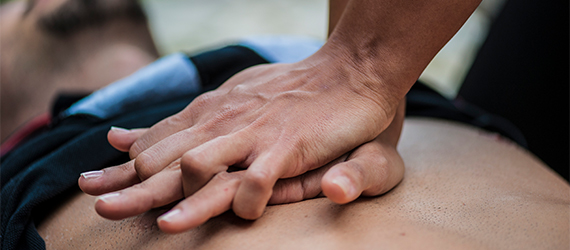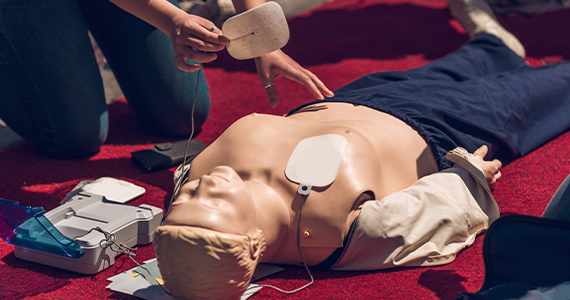In a normal heart, electrical signals cause the two upper chambers of the heart (atria) to contract and pump blood to the two lower chambers of the heart (ventricles). Thereafter, the electrical signals cause the ventricles to contract and pump the blood to lungs and rest of the body. However, when the electrical signals malfunction and turn faulty, the heart beats too fast or too slow or irregularly and collectively these conditions are known as Arrhythmias.
One type of Arrhythmia is ‘Ventricular Fibrillation’ (V-fib). In this case, rapid irregular electrical signals cause the ventricles to quiver or twitch instead of contracting. Due to this, blood stops flowing to the rest of the body and within seconds, breathing ceases, the pulse is absent and consciousness is lost. This is called Sudden Cardiac Arrest (SCA). Without oxygenated blood,
One type of Arrhythmia is ‘Ventricular Fibrillation’ (V-fib). In this case, rapid irregular electrical signals cause the ventricles to quiver or twitch instead of contracting. Due to this, blood stops flowing to the rest of the body and within seconds, breathing ceases, the pulse is absent and consciousness is lost. This is called Sudden Cardiac Arrest (SCA). Without oxygenated blood, brain cells can survive only for 6 minutes. Brain cells then start dying and when a critical number of these cells die death occurs.
brain cells can survive only for 6 minutes. Brain cells then start dying and when a critical number of these cells die death occurs.
SCA most commonly occurs during an acute heart attack or shortly thereafter. When heart muscle does not get enough blood flow, it can become electrically unstable and this causes dangerous Arrhythmias. A heart that has been damaged by a heart attack or other heart muscle damage such as heart failure, coronary artery disease, enlarged heart, thickened heart muscle and congenital heart diseases is vulnerable to SCA. Often, SCA occurs in a person with a pre- existing, possibly undiagnosed heart condition. Non-heart disease causes include road accident, drowning, asphyxia, electrocution, drug overdose, poisoning, blows on chest etc.
(a) Ask for a cardiac ambulance by calling local ambulance services or nearest hospitals (who have their own ambulances)
(b) Place the victim on his or her back on a hard surface and check breathing. If it is absent, it means that the victim has suffered a Sudden Cardiac Arrest.
(c) Open the airway by tilting the head back and lifting their chin.
(d) Place the heel of one hand at the centre of the person's chest (on the breastbone) and covering the first hand with the other hand.
(e) Start Hands-Only CPR by keeping your elbows straight and using your upper body weight to push down hard and fast on the person's chest at a rate of about 100 compressions a minute.
(f) Once the ambulance arrives on scene, allow their medical staff to take over.
(a) While continuing with CPR as outlined under 'a' to 'e' above, bare the chest by removing clothing. Switch-on the AED and follow the voice prompts. Attach the AED’s pads: One on the upper right side of the chest and the other on the lower left side of the chest. Plug the pad connector cable into the AED, in case it is a detachable type.
(b) Stop CPR momentarily, and allow the AED to analyse heart’s rhythm and follow the voice prompts. Do not touch the victim or AED to avoid interference with the analysis.
(c) If the AED determines that shock is needed, everyone to stay clear of the victim and ‘shock’ button is pressed to deliver the shock.
(d) If AED’s shock doesn’t result in breathing, restart CPR. This interruption in CPR should be for shortest possible duration.
(e) AED will reassess the heart rhythm every 2 minutes and advise if another shock is needed. If yes, stay clear from the victim and deliver shock as done earlier. If no shock is advised, continue with CPR and follow AED’s prompts
(f) Once the ambulance arrives on scene, allow their medical staff to take over.

The procedure outlined above is Hands-Only CPR (HOCPR) since it involves chest compressions only. It can be performed even by untrained responders. HOCPR is effective because chest compressions ensure that blood continues to circulate to provide oxygen to vital organs like brain, lungs and heart.
Traditional CPR involves chest compressions with regular interruption to give mouth-to-mouth resuscitation. Every 30 compressions were followed by 2 rescue breaths. However, this form of CPR can be performed only by trained responders.
The first 5-6 minutes after SCA are crucial. Carrying out CPR within the first 5-6 minutes after a Sudden Cardiac Arrest can save the life of over 50% patients. Chances of survival reduce by 7-10% with every passing minute. Unfortunately, many people die because most bystanders do not come forward to carry-out CPR in India
The first 5-6 minutes after SCA are crucial. Carrying out CPR within the first 5-6 minutes after a Sudden Cardiac Arrest can save the life of over 50% patients. Chances of survival reduce by 7-10% with every passing minute. Unfortunately, many people die because most bystanders do not come forward to carry-out CPR in India since they do not have even a rudimentary idea of CPR. This campaign’s objective is make people aware of CPR and how it can help save lives.

since they do not have even a rudimentary idea of CPR. This campaign’s objective is make people aware of CPR and how it can help save lives.


Defibrillation is the technique adopted to stop ventricular fibrillation, referred to above. Automated External Defibrillators or AEDs are portable electronic medical devices that provide defibrillation through electrical shock/s. AEDs will automatically determine the heart rhythm of a pulseless victim and, if the victim is in ventricular fibrillation (V-fib), shock the victim's heart to restore the cardiac rhythm
AEDs can be found in many public areas including most malls, stadiums and airports. They are straightforward and easy to use, since they are equipped by simple audio and visual commands. Buying an AED to retain at home or donating an AED to neighbourhood organisations would greatly support this campaign to save lives.
Handling cardiac emergencies is still a question mark in India. For instance, when a person collapses on the street, crowd builds-up and in the confusion precious time is wasted. Most of the time, bystanders are unaware or untrained in CPR and are afraid of doing something wrong. The first thought of bystanders is to sprinkle water on the person to revive him or her. Obviously, that will not help an unconscious Sudden Cardiac Arrest patient.
Another wrong practice is to place the person in any vehicle available at the spot and shift him or her to the nearest hospital. During the crucial first 4-6 minutes, instead of receiving CPR, the
Another wrong practice is to place the person in any vehicle available at the spot and shift him or her to the nearest hospital. During the crucial first 4-6 minutes, instead of receiving CPR, the patient is just being moved and as a result would be found dead on arrival at hospital. Even at home, when cardiac emergencies occur, the caregivers or family members panic as they do not know exactly what has to be done.
patient is just being moved and as a result would be found dead on arrival at hospital. Even at home, when cardiac emergencies occur, the caregivers or family members panic as they do not know exactly what has to be done.
Women who suffer Sudden Cardiac Arrest outdoors are at a greater risk. Male bystanders remain reluctant to carry out CPR on women, for fear of touching breasts. This fear is misplaced because CPR compressions are not to be done on breasts but on sternum which is a long, flat bone located between the breasts.
Even though CPR is the crucial and basic procedure to save a life during Sudden Cardiac Arrest, 98% of Indians are not trained in it. The need of the hour is that at least one member from each family is trained in CPR. CPR training is simple and can be learnt by anyone. It is not necessary for the learner to be from Sciences background. Training is provided by doctors and healthcare professionals. Should it not be possible to attend the training, one can get a basic knowledge of CPR by watching videos.
The ‘Basic Life Support (BLS)’ & first aid course is about 8 hours duration. The course includes life-saving techniques such as CPR,
The ‘Basic Life Support (BLS)’ & first aid course is about 8 hours duration. The course includes life-saving techniques such as CPR, usage of a defibrillator and the basics of first-aid such as dressing cuts, scrapes, wounds and fractures. You are also taught examining an unconscious person, checking if the neck has a pulse and what to do to resuscitate people in different circumstances.
usage of a defibrillator and the basics of first-aid such as dressing cuts, scrapes, wounds and fractures. You are also taught examining an unconscious person, checking if the neck has a pulse and what to do to resuscitate people in different circumstances.
Trainers demonstrate CPR by carrying out chest compressions on mannequins. The right posture, the right location (i.e. breastbone), right placement of palms of hands, speed needed to ensure 100 compressions per minute are all demonstrated. This is followed by each participant carrying out CPR on the mannequins.
Studies have revealed that genetically South Asians are at higher risk for cardiac disease and also, heart attacks strike at a younger age compared to other ethnic groups. Compounding the problem are sedentary routines and unhealthy dietary habits that cause lifestyle disorders like diabetes and hypertension which in turn lead to coronary artery disease.
The end result is that there is a greater incidence of heart diseases among Indians and Sudden Cardiac Arrest is one of the main outcomes. To tackle this challenge, Indians need to get trained in CPR so as to give a chance of survival to their loved ones or even otherwise to people at large.